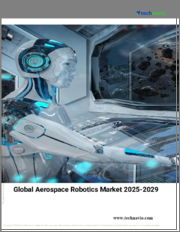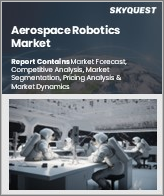
|
시장보고서
상품코드
1577082
우주 로봇 시장, 기회, 성장 촉진요인, 산업 동향 분석과 예측(2024-2032년)Space Robotics Market, Opportunity, Growth Drivers, Industry Trend Analysis and Forecast, 2024-2032 |
||||||
세계의 우주 로봇 시장은 2023년에 46억 5,000만 달러로 평가되며, 2024-2032년 CAGR 5% 이상의 성장이 전망되고 있습니다.
AI, 머신러닝, 로봇공학 등의 기술 발전으로 더욱 정교한 우주 로봇이 개발되고 있습니다. 이러한 로봇은 위성 유지보수, 우주 탐사, 이물질 제거 등 높은 정밀도와 신뢰성이 요구되는 작업에 필수적입니다.
우주 임무 증가와 정부 및 민간 부문의 우주 탐사에 대한 관심 증가가 이 시장의 주요 촉진요인으로 작용하고 있습니다. 정부의 우주 프로그램에 대한 투자와 민간 부문의 상업적 우주 여행에 대한 노력으로 인해 우주라는 혹독한 조건에서 작동하는 데 필수적인 첨단 로봇 시스템에 대한 수요가 급증하고 있습니다.
지속가능한 우주 활동의 필요성도 우주 로봇 시장을 촉진하고 있습니다. 우주 쓰레기에 대한 우려가 커지면서 궤도상의 잔해물을 식별하고 제거하여 보다 안전한 우주 운영을 보장하기 위한 로봇이 개발되고 있습니다. 또한 국제우주정거장(ISS)과 미래의 화성 및 달 기지 등 우주 인프라의 건설 및 유지보수에도 로봇의 활용이 진행되고 있습니다. 이처럼 지속가능성과 우주 사업의 장기적 실행 가능성에 대한 중요성이 강조되면서 로봇 시스템에 대한 지속적인 수요가 확보되고 있습니다.
시장은 용도별로 심우주, 근우주, 지상으로 구분됩니다. 심우주 분야는 화성 및 소행성 탐사 등 지구 궤도를 벗어난 탐사에 대한 관심 확대에 힘입어 2032년까지 40억 달러 이상의 규모로 성장할 것으로 예상됩니다. 이러한 까다로운 환경에서의 시료 채취, 지표 탐사, 거주지 건설 등의 작업에는 첨단 로봇 시스템이 필수적이며, AI, 로봇 공학, 재료 과학의 발전으로 심우주의 극한 조건을 견딜 수 있는 더욱 견고한 로봇이 개발되고 있습니다.
최종사용자에 따라 시장은 상업, 정부, 국방으로 나뉩니다. 정부 부문이 가장 빠르게 성장하고 있으며, 2024-2032년 연평균 복합 성장률(CAGR)이 5%를 초과할 것으로 예상됩니다. 정부는 우주 탐사에 많은 투자를 하고 있으며, 위성 서비스, 행성 탐사 및 궤도 조립을 위한 첨단 로봇 시스템에 대한 수요를 주도하고 있습니다. 정부 주도의 혁신과 연구는 더욱 정교한 우주 로봇의 개발을 촉진하고 있습니다.
2023년 세계 우주 로봇 시장은 북미가 35% 이상의 점유율을 차지할 것으로 예상됩니다. 이 지역은 NASA와 같은 주요 기업과 우주 로봇 연구 및 기술 발전에 기여하는 수많은 비상장 기업이 주도하는 강력한 인프라의 혜택을 누리고 있습니다. 미국은 우주 탐사 및 기술 혁신에 대한 광범위한 투자에 힘입어 우주 로봇 분야의 세계 리더로 자리매김하고 있습니다.
목차
제1장 조사 방법과 조사 범위
제2장 개요
제3장 업계 인사이트
- 에코시스템 분석
- 벤더 매트릭스
- 이익률 분석
- 테크놀러지와 혁신 전망
- 특허 분석
- 주요 뉴스와 구상
- 규제 상황
- 영향요인
- 촉진요인
- AI와 로봇 공학의 기술적 진보
- 우주 미션의 증가
- 지역 자원을 활용한 비용 삭감
- 우주 사업의 지속가능성과 안전성
- 장기적인 우주 탐사 목표
- 업계의 잠재적 리스크 & 과제
- 자율형 우주 로봇의 기술적 복잡성
- 높은 초기 투자 비용
- 촉진요인
- 성장 가능성 분석
- Porter의 산업 분석
- PESTEL 분석
제4장 경쟁 구도
- 서론
- 기업 점유율 분석
- 경쟁 포지셔닝 매트릭스
- 전략 전망 매트릭스
제5장 시장 추산·예측 : 용도별, 2021-2032년
- 주요 동향
- 심우주
- 혹성 탐사
- 소행성 채굴
- 우주 조사
- 근방 우주
- 위성 운영
- 우주 스테이션 정비
- 궤도 운송
- 기타
- 지상
- 발사 오퍼레이션
- 지상 관제 업무
- 우주 연구소
제6장 시장 추산·예측 : 솔루션별, 2021-2032년
- 주요 동향
- 원격 조작기(ROV)
- 로버/우주선 착륙기
- 우주 탐사기
- 기타
- 원격 매니퓰레이터 시스템(RMS)
- 로봇 암/매니퓰레이터 시스템
- 그리핑·도킹 시스템
- 기타
- 소프트웨어
- 서비스
제7장 시장 추산·예측 : 최종사용자별, 2021-2032년
- 주요 동향
- 상업
- 관공청
- 방위
제8장 시장 추산·예측 : 기술별, 2021-2032년
- 주요 동향
- 원격탐사
- 자율 시스템
- 원격 조작
- 로봇 소프트웨어
- 인공지능(AI)과 기계학습(ML)
- 인간과 로봇 상호작용
제9장 시장 추산·예측 : 지역별, 2021-2032년
- 주요 동향
- 북미
- 미국
- 캐나다
- 유럽
- 영국
- 독일
- 프랑스
- 이탈리아
- 스페인
- 기타 유럽
- 아시아태평양
- 중국
- 인도
- 일본
- 한국
- 뉴질랜드
- 기타 아시아태평양
- 라틴아메리카
- 브라질
- 멕시코
- 기타 라틴아메리카
- 중동 및 아프리카
- UAE
- 남아프리카공화국
- 사우디아라비아
- 기타 중동 및 아프리카
제10장 기업 개요
- AIKO
- Altius Space Machine
- Astrobotic Technology
- Blue Origin
- BluHaptics, Inc.
- GITAI
- Honeybee Robotics
- Intuitive Machines, LLC.
- Ispace
- ITT Corporation
- Lunar Outpost
- Masten Space Systems
- MAXAR TECHNOLOGIES
- Metecs, LLC.
- Motiv Space Systems, Inc.
- NASA Jet Propulsion Laboratory(JPL)
- Northrop Grumman.
- Oceaneering International, Inc.
- Olis Robotics
- Sierra Nevada Corporation
- SpaceX
- TransAstra Corporation
The Global Space Robotics Market was valued at USD 4,650.0 million in 2023 and is expected to grow at a CAGR of over 5% from 2024 to 2032. Technological advancements in areas such as AI, machine learning, and robotics have led to the development of more sophisticated space robots. These robots are essential for tasks like satellite maintenance, space exploration, and debris removal, which require high precision and reliability.
The growing number of space missions and increased interest in space exploration by both government and private sectors are key drivers of this market. Government investments in space programs and private sector initiatives for commercial space travel have created a surge in demand for advanced robotic systems, which are critical for operating in the challenging conditions of space.
The need for sustainable space operations also drives the space robotics market. Space debris has become a growing concern, and robots are being developed to identify and remove debris from orbit, ensuring safer space operations. Additionally, robots are increasingly utilized for constructing and maintaining space infrastructure, including the International Space Station (ISS) and future Martian or lunar bases. This emphasis on sustainability and the long-term viability of space operations ensures continued demand for robotic systems.
The overall space robotics industry is categorized based on Application, Solution, End User, Technology, and Region.
The market is segmented by application into deep space, near space, and ground. The deep space segment is projected to reach a value of over USD 4 billion by 2032, driven by expanding interest in exploring beyond Earth's orbit, such as missions to Mars and asteroids. Advanced robotic systems are essential for tasks such as sample collection, surface exploration, and habitat construction in these challenging environments. Improvements in AI, robotics, and materials science are enabling more robust robots capable of enduring the extreme conditions of deep space.
Based on the end user, the market is divided into commercial, government, and defense. The government segment is the fastest-growing, with a CAGR of over 5% from 2024 to 2032. Governments are heavily investing in space exploration, driving demand for advanced robotic systems for satellite servicing, planetary exploration, and in-orbit assembly. Government-led innovations and research are pushing the development of more sophisticated space robots.
North America dominated the global space robotics market in 2023, with over 35% market share. The region benefits from its strong infrastructure, driven by leading agencies like NASA and numerous private companies that contribute to research and technological advancements in space robotics. The United States remains a global leader in space robotics, backed by extensive investments in space exploration and innovation.
Table of Contents
Chapter 1 Methodology and Scope
- 1.1 Market scope and definition
- 1.2 Base estimates and calculations
- 1.3 Forecast calculation
- 1.4 Data sources
- 1.4.1 Primary
- 1.4.2 Secondary
- 1.4.2.1 Paid sources
- 1.4.2.2 Public sources
Chapter 2 Executive Summary
- 2.1 Industry 360º synopsis, 2021 - 2032
Chapter 3 Industry Insights
- 3.1 Industry ecosystem analysis
- 3.2 Vendor matrix
- 3.3 Profit margin analysis
- 3.4 Technology and innovation landscape
- 3.5 Patent analysis
- 3.6 Key news and initiatives
- 3.7 Regulatory landscape
- 3.8 Impact forces
- 3.8.1 Growth drivers
- 3.8.1.1 Technological advancements in AI and robotics
- 3.8.1.2 Increased number of space missions
- 3.8.1.3 Cost reduction using local resources
- 3.8.1.4 Sustainability and safety in space operations
- 3.8.1.5 Long-term space exploration goals
- 3.8.2 Industry pitfalls and challenges
- 3.8.2.1 Technical complexities of autonomous space robots
- 3.8.2.2 High initial investment costs
- 3.8.1 Growth drivers
- 3.9 Growth potential analysis
- 3.10 Porter's analysis
- 3.10.1 Supplier power
- 3.10.2 Buyer power
- 3.10.3 Threat of new entrants
- 3.10.4 Threat of substitutes
- 3.10.5 Industry rivalry
- 3.11 PESTEL analysis
Chapter 4 Competitive Landscape, 2023
- 4.1 Introduction
- 4.2 Company market share analysis
- 4.3 Competitive positioning matrix
- 4.4 Strategic outlook matrix
Chapter 5 Market Estimates and Forecast, By Application, 2021 - 2032 (USD million)
- 5.1 Key trends
- 5.2 Deep space
- 5.2.1 Planetary exploration
- 5.2.2 Asteroid mining
- 5.2.3 Space Research
- 5.3 Near space
- 5.3.1 Satellite operations
- 5.3.2 Space station maintenance
- 5.3.3 Orbital transportation
- 5.3.4 Others
- 5.4 Ground
- 5.4.1 Launch operations
- 5.4.2 Ground control operations
- 5.4.3 Space research labs
Chapter 6 Market Estimates and Forecast, By Solution, 2021 - 2032 (USD million)
- 6.1 Key trends
- 6.2 Remotely Operated Vehicles (ROV)
- 6.2.1 Rovers/Spacecraft Landers
- 6.2.2 Space probes
- 6.2.3 Others
- 6.3 Remote Manipulator System (RMS)
- 6.3.1 Robotic Arms/Manipulator Systems
- 6.3.2 Gripping and Docking Systems
- 6.3.3 Others
- 6.4 Software
- 6.5 Services
Chapter 7 Market Estimates and Forecast, By End User, 2021 - 2032 (USD million)
- 7.1 Key trends
- 7.2 Commercial
- 7.3 Government
- 7.4 Defense
Chapter 8 Market Estimates and Forecast, By Technology, 2021 - 2032 (USD million)
- 8.1 Key trends
- 8.2 Remote sensing
- 8.3 Autonomous systems
- 8.4 Teleoperation
- 8.5 Robotic software
- 8.6 Artificial Intelligence (AI) and Machine Learning (ML)
- 8.7 Human-Robot interaction
Chapter 9 Market Estimates and Forecast, By Region, 2021 - 2032 (USD million)
- 9.1 Key trends
- 9.2 North America
- 9.2.1 U.S.
- 9.2.2 Canada
- 9.3 Europe
- 9.3.1 UK
- 9.3.2 Germany
- 9.3.3 France
- 9.3.4 Italy
- 9.3.5 Spain
- 9.3.6 Rest of Europe
- 9.4 Asia Pacific
- 9.4.1 China
- 9.4.2 India
- 9.4.3 Japan
- 9.4.4 South Korea
- 9.4.5 ANZ
- 9.4.6 Rest of Asia Pacific
- 9.5 Latin America
- 9.5.1 Brazil
- 9.5.2 Mexico
- 9.5.3 Rest of Latin America
- 9.6 MEA
- 9.6.1 UAE
- 9.6.2 South Africa
- 9.6.3 Saudi Arabia
- 9.6.4 Rest of MEA
Chapter 10 Company Profiles
- 10.1 AIKO
- 10.2 Altius Space Machine
- 10.3 Astrobotic Technology
- 10.4 Blue Origin
- 10.5 BluHaptics, Inc.
- 10.6 GITAI
- 10.7 Honeybee Robotics
- 10.8 Intuitive Machines, LLC.
- 10.9 Ispace
- 10.10 ITT Corporation
- 10.11 Lunar Outpost
- 10.12 Masten Space Systems
- 10.13 MAXAR TECHNOLOGIES
- 10.14 Metecs, LLC.
- 10.15 Motiv Space Systems, Inc.
- 10.16 NASA Jet Propulsion Laboratory (JPL)
- 10.17 Northrop Grumman.
- 10.18 Oceaneering International, Inc.
- 10.19 Olis Robotics
- 10.20 Sierra Nevada Corporation
- 10.21 SpaceX
- 10.22 TransAstra Corporation



















